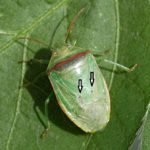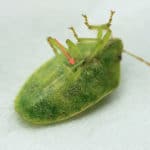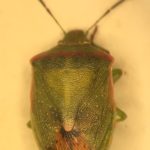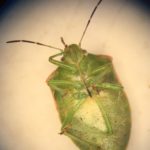Many of our early soybean fields are turning yellow and came through the season not needing an insecticide application. I’ve had a number of calls about threshold levels of kudzu bugs in some of these fields. The threshold is 1 nymph/sweep, and some fields are running 2-3 times this level. Although this exceeds threshold, I’m having a hard timing pulling the trigger in beans that are past R6. Unless populations are more than 2-3 times threshold, I don’t expect yield loss of more than 1-3 bushels per acre (only an educated guess). This level of yield loss often occurs when driving a sprayer through a field. Indeed, I suggest aerial application where possible if treatment for late season insect pests is needed. The extra cost of application is more than offset by reduced mechanical damage from a sprayer driving through a field.
There is confusion about the identification of redbanded stink bugs. This species causes more damage and requires more aggressive management than the other stink bugs we typically encounter in soybean. I’ve written about management and provided pictures of redbanded stink bugs in a previous article. It never fails that another species of stink bug is confusing the issue. The red shouldered stink bug sometimes occurs in soybean. The adults often have a pink band across the back, and may have pink shoulders. There are a couple of characteristics to help distinguish this relatively non-damaging stink bug from the redbanded stink bug (see the images below).
- Redbanded stink bugs have relatively round shoulders, whereas the red shouldered stink bug has more pointed shoulders.
- You will usually see two back dots on the back of adult redbanded stink bugs.
- The redbanded stink bug, including large nymphs, have a prominent spine between their hind legs, whereas red shouldered stink bugs do not have a spine.
- There is a good publication from the University of Arkansas about identifying stink bugs often found in soybean – https://www.uaex.edu/publications/PDF/FSA-7078.pdf.

I’m also getting reports of soybean loopers approaching threshold levels in some later maturing soybean fields. The suggested threshold is when defoliation exceeds 20% prior to R6, or exceeds 30% beginning at R6 for the next 7-10 days. Treatment is also recommended if larval counts exceed 19/25 sweeps, but it is often suggested to ignore larvae < 1/2 inch because they do little feeding and have a high mortality rate. It seems obvious, but if your field is turning yellow, don’t treat for defoliating insects!
Consistent soybean looper control requires the use of selective and somewhat more expensive insecticide. Pyrethroid insecticides are NOT recommended … they stink at controlling loopers. Some of my favorite looper treatments include Intrepid Edge (4 oz/acre), Blackhawk (1.5 – 1.75 oz/acre), Intrepid (4 – 6 oz/acre), Besiege (10 oz/acre), Steward (7 – 9 oz/acre), and Prevathon (14 oz/acre). Some tank mixing will be needed if fields also require treatment for stink bugs.






One thought on “Soybean insect update and identifying redbanded stink bugs”
Comments are closed.